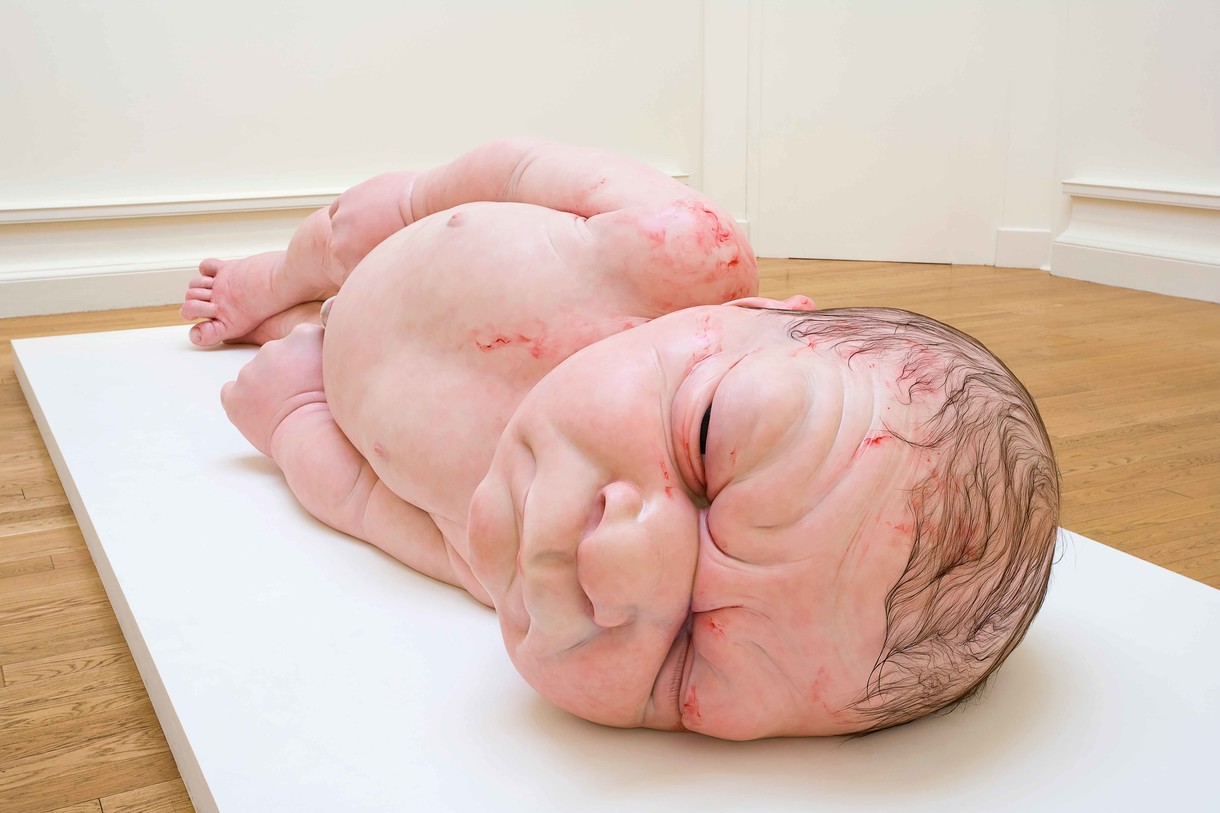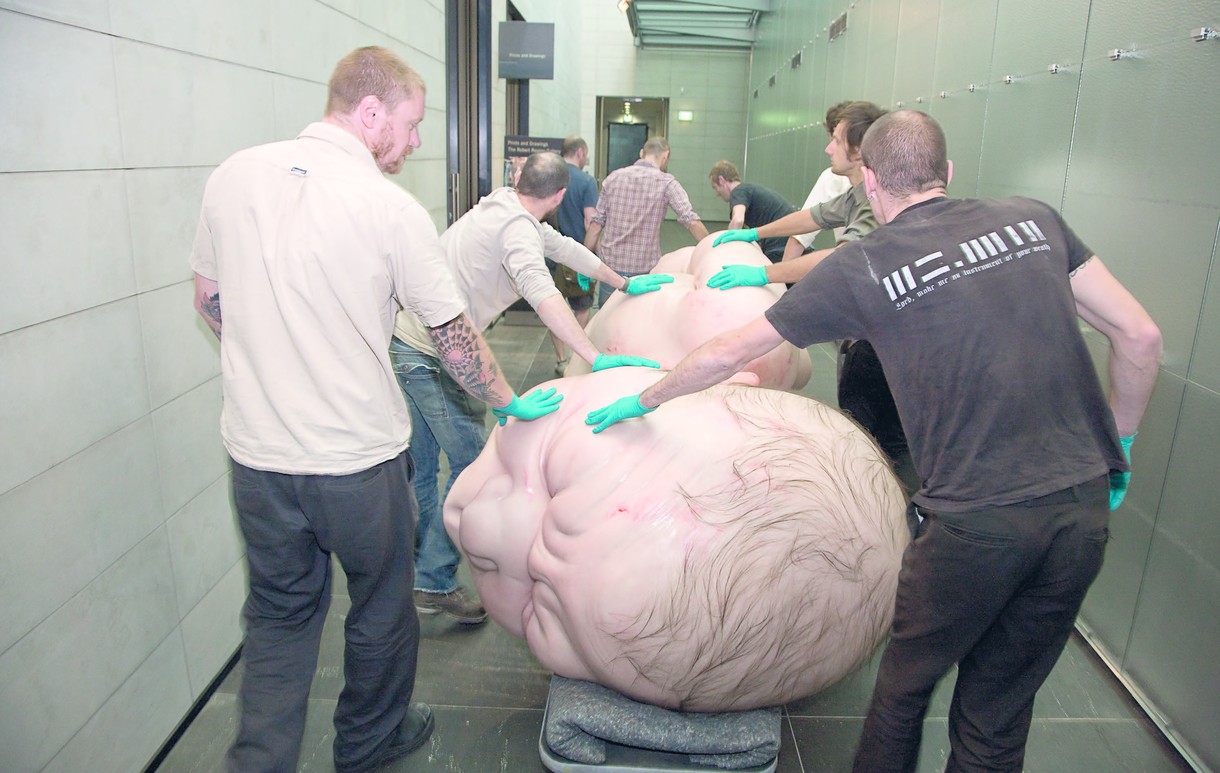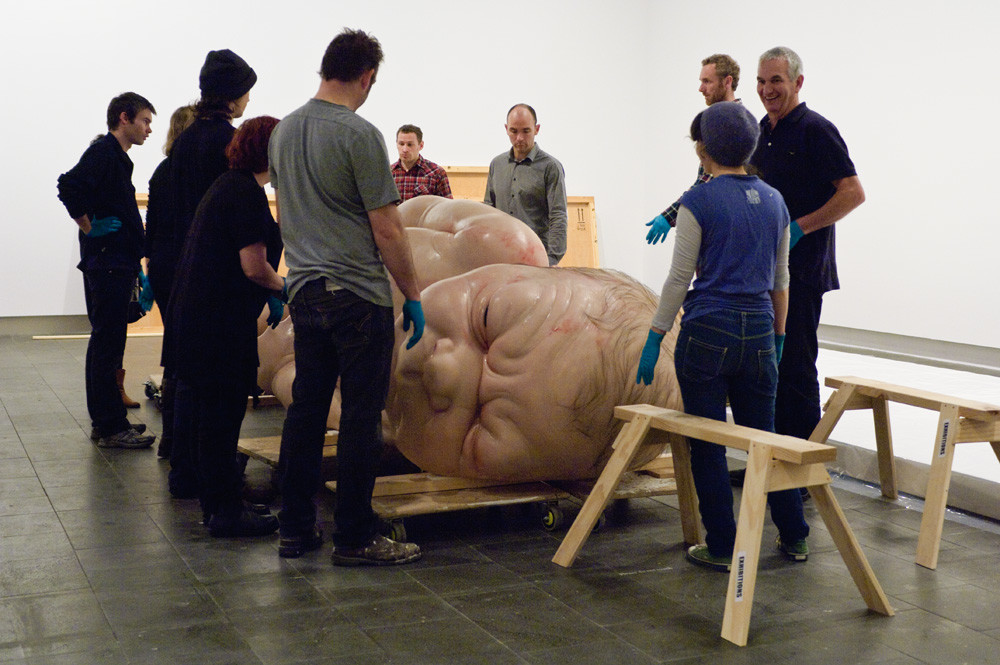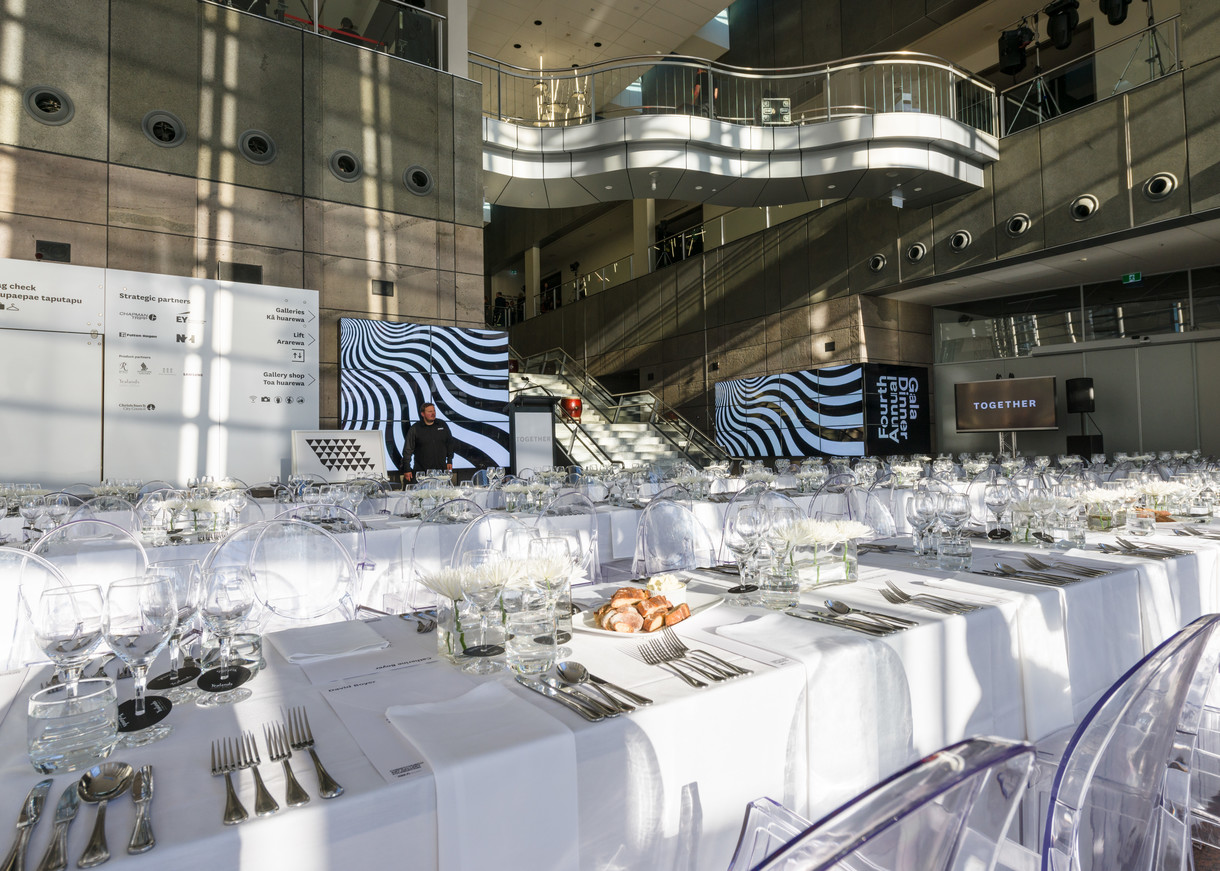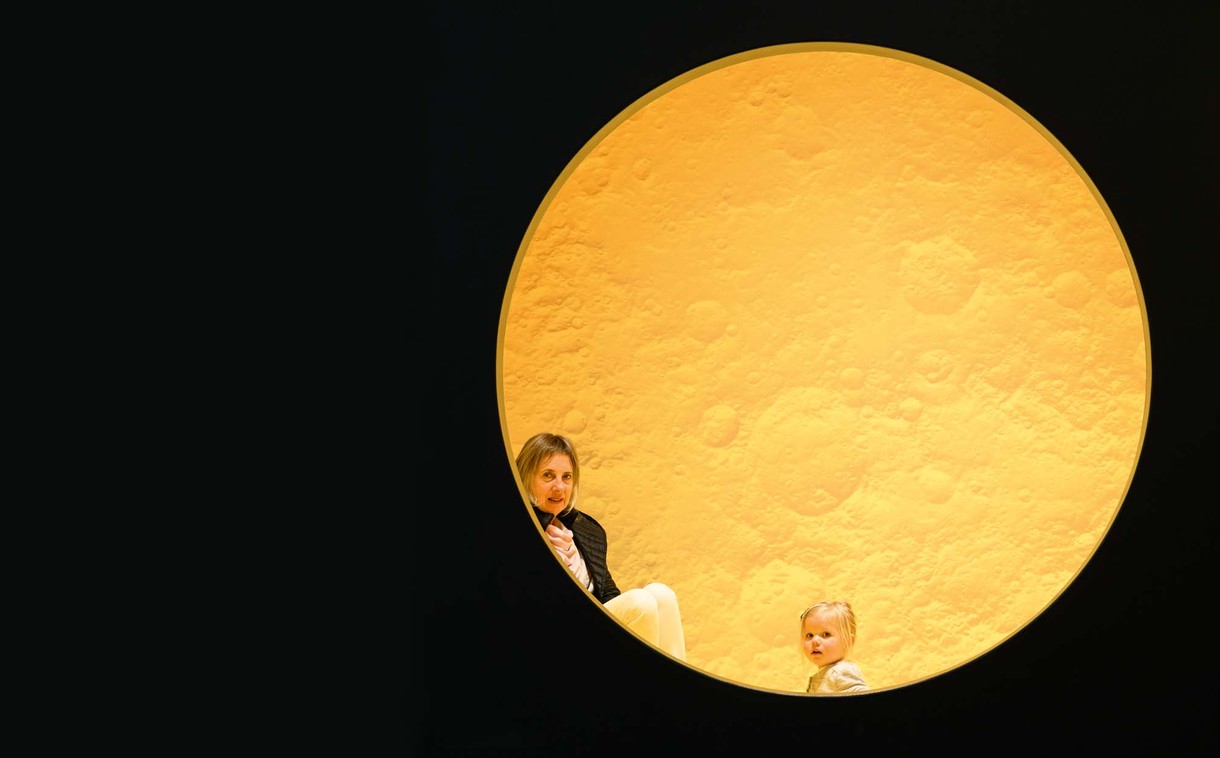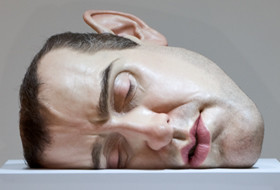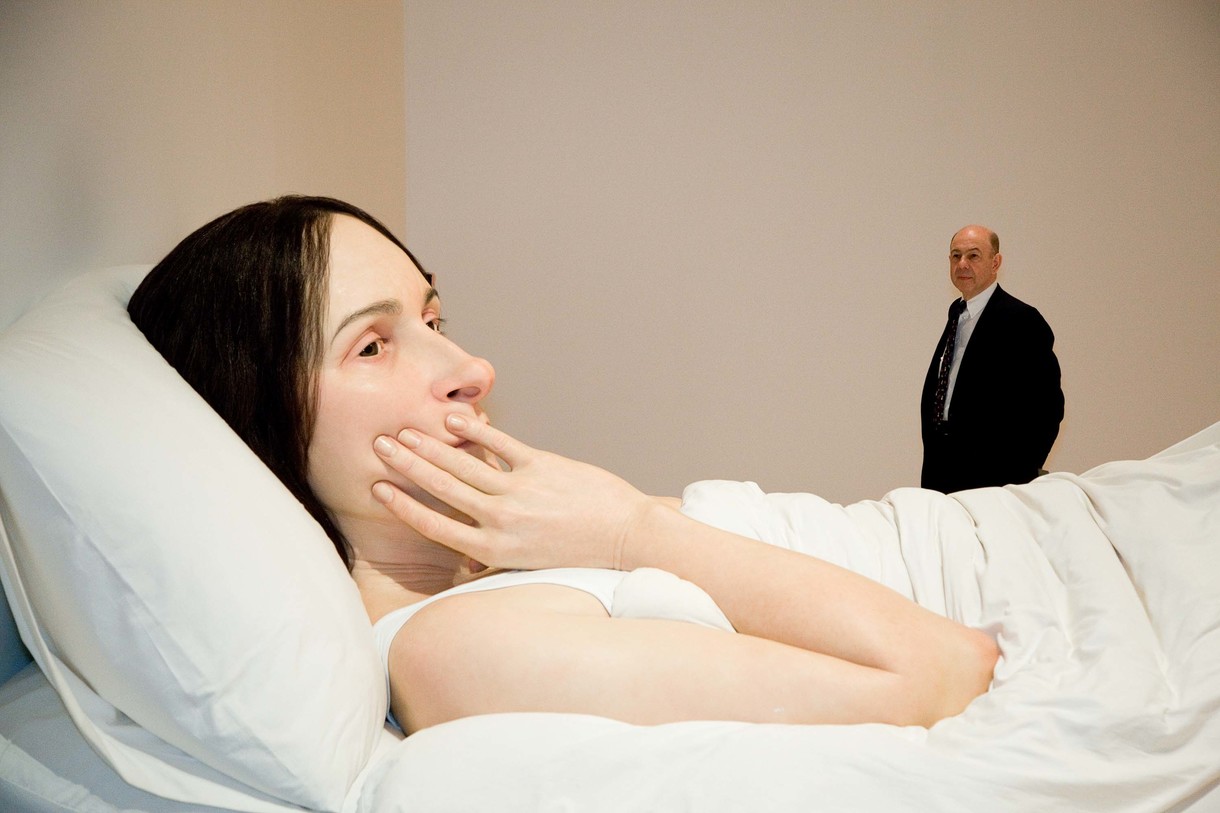Shyness and sculpture
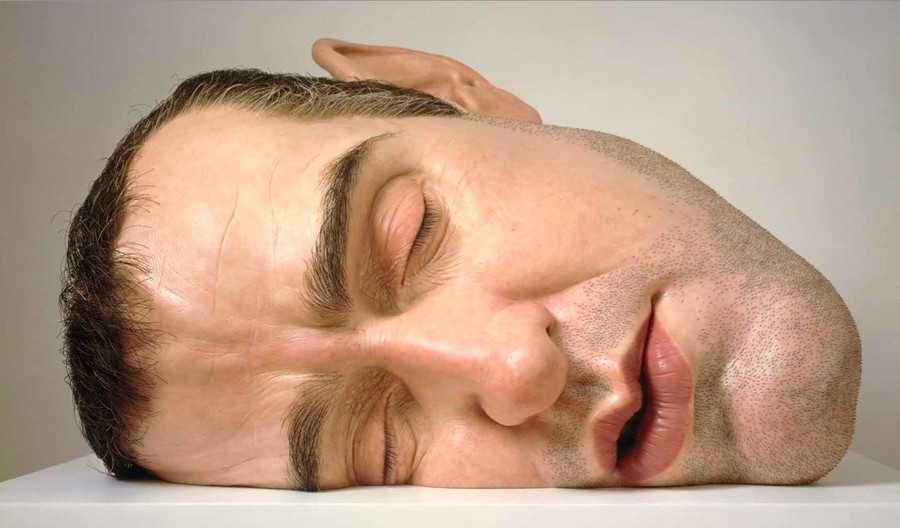
Ron Mueck Mask II 2002. Polyester resin, fibreglass, steel, plywood, synthetic hair, second edition, artist's proof. Private collection. © Ron Mueck courtesy Anthony d'Offay, London
Reporters like to begin their stories about Ron Mueck by noting that he is famously media-shy. Since television and newspapers thrive on personality, celebrity and ‘direct access' to the stars, journalists clearly feel it necessary to explain to their audiences that they won't be hearing from the artist himself. Beyond this, however, not much more gets said about Mueck's reluctance to talk. It's treated as a minor difficulty, something to be mentioned in passing before moving on to the artworks. And for that reason, surely it's not the kind of thing I should be bringing up in an official essay...
But I have a suspicion there's more to it.
I started wondering about the role of shyness in the sculptures earlier this year during a face-to-face encounter with Ron Mueck. Not with the man himself, but with the astonishing sculpture he made of his own head in 2002. Drawn in from across the gallery by the sight of this colossal, lone, sleeping face, I could see the pull of gravity on his cheeks, glimpse the shine of saliva inside his mouth, and trace-whisker by fastidiously implanted whisker – the swarm of stubble on his chin. If I came close enough, I felt sure I might hear the whistle of breath through the lips. Here, it seemed, was an example of self-portraiture at its most extreme-a sculpture that tells us everything there is to know about this person and then some; an act of complete and unflinching self-exposure.
Yet the more time I spent with the work, the less certain I felt about what exactly was being exposed. After all, whatever Mueck is thinking or feeling in this sculpture is hidden behind those closed eyes. And the sense of concealment is heightened by the fact that he's not just lying there but deep in sleep, that state in which our identities turn oceanic and we are no longer fully ourselves. All this is compounded by the surprise that waits when you walk behind the work and discover that it's hollow-no storehouse of self, no inner workings, just a scooped-out shell of resin. And finally there is the work's title, which is not ‘self-portrait' or ‘me asleep' but rather Mask II – a title which tells us in no uncertain terms that something is being hidden by this face.
Slowly but surely, by means of these small hints and clues, Mueck turns the self-portrait idea inside out. Far from being an act of self-exposure, the sculpture strikes me now as an assertion of privacy and dreaming inwardness. Made three years after Mueck's arrival on the British art scene, at a time of intense media interest in the man behind these extraordinary objects, it's a sculpture that marks the limit between what we can see of someone and what we can know of them-and as such it's a kind of manifesto of Mueck's art. With Mueck, I think, shyness is not just a side-issue to note before moving on to the sculptures and their dazzling technique. It's a key to the works themselves, and one of the reasons Mueck goes to such lengths. Rather than simply being media-shy, Mueck is an artist of shyness-a sculptor who wants to describe, using resin, microfilament, hair and paint, the mysterious threshold between the way we look to the world and the way we feel to ourselves.
—2—
You could argue that sculpture is the least shy kind of art there is. Unlike paintings, which hang flat on walls and permit us to walk right past them, figurative sculptures occupy the same space as we do and demand to be noticed. Heavy, hard to move, and frequently larger than life-size, they're artworks that literally get in our way. That's especially so with figure sculptures of the public-spirited, civic-minded kind, which rise up in the centre of communal spaces and deliver their messages to one and all. Usually created to mark an epic victory, mourn a great loss, or celebrate an official achievement, these are sculptures that speak loudly and clearly on their chosen topics – and assume that they are going to be heard. There's nothing shy about them. That is why walking into a gallery populated with Ron Mueck's sculptures is so startling. At first glance what's before you doesn't look so different from a traditional sculpture hall, with human figures of different sizes arrayed through the space on plinths. But beyond that, everything is different. Instead of the sheen of bronze or the hardness of stone, there's the mottled vulnerability of painted skin. Instead of grand messages and public allegories, there are private narratives and submerged psychologies that are sensed rather than fully revealed. If traditional figure sculptures are exhibitionists, eager to be seen by one and all, Mueck's figures are introverts, who seem to respond to being placed on public view by retreating into themselves.
Look through Mueck's career and it's striking how many sculptures appear to retreat in this way – to take cover from inquisitive gallery-goers. Man in a sheet shrouds himself and stares down, forcing viewers to crouch to see his expression. Man under cardigan is equally reclusive, looking out gloomily from a comically inadequate shelter. Big man is a behemoth who tries but fails to hide his bulk in a corner of the gallery and slides us an accusing gaze, as if we're responsible for putting him there on display. The adolescent girl in Ghost seems to shrink from our gaze even as her body pushes tyrannically upwards – seven-foot high and still growing. Meanwhile Mueck's Two women lean together and fashion a small space of privacy for themselves, as if suspicious of our presence and hopeful we'll soon leave them in peace. Of course, since this is a gallery and they are all just artworks, we don't leave any of these figures in peace, preferring instead to linger and stare as closely as we can at their skin, their fingernails, their hair. But it's impossible to do so without a faint sense of trespass, of seeing more of someone than they would want you to.
In other words, Mueck is not just making convincing sculptures of how people look. He's making sculptures about how it feels to be looked at. And no one in his cast of characters appears to dislike the experience more than Wild man, who I first saw rising up above crowds of well-heeled (and very un-wild) people at the opening of Mueck's Melbourne exhibition. We all know exhibition openings can be awkward occasions, but Wild man looked like he was having an especially uncomfortable evening – his nostrils flared, his toes clawing the ground, his huge head and beard semaphoring panic. Four metres tall if he stood up, Wild man is as big as the statues of popes and generals that once populated churches and public squares. But Mueck's genius in this work is to make bigness do the very opposite of what it does in older monumental statues. Far from signifying power, Wild man's bigness evokes the sensation we've all had in grim social situations, of feeling too prominent, too visible, too large - of wanting to shrink from public view and disappear. It's telling that viewers respond to Wild man not with revulsion but with a smile; I think they recognise his predicament, and sympathise.
With Wild man the eyes have it; he seems to see us and panic. But for me the most moving of Mueck's figures are those that do not see us viewers at all – figures that seem conscious and lifelike precisely because they do not meet our eyes. Take the sculpture In bed, with its colossal reclining woman. Despite her size, she's removed from us by the mountainous rise of her bedspread. Once we stand beside her, what we want instinctively is connection, recognition, eye contact. But her gaze goes right through us and rests instead on some distant, unspoken worry. And her gesture – fingers pillowed in the skin of her cheek – enforces the sense of separation, as if she's absently comforting herself rather than reaching out to someone else. Standing beside this enormous woman, each viewer takes the part of a child standing at their mother's bedside and realising she has something else – something other than you – on her mind. We can hatch our own stories about the source of her worries – an illness, or loss, or just an unpaid bill – but in the end there's no way of knowing. This is a sculpture about intimacy and distance, about how close you can go and still not know, and how giddying the not knowing can feel.
Mueck's boldest combination of intimacy and distance is Pregnant woman from 2002. A sculpture of a naked woman about to give birth would be extraordinary enough at life-size. But at this size, over eight-feet tall, it's almost hallucinatory – her belly booming outward, her back buttressed against its weight, her feet planted with awesome solidity. We can see her popped navel, the shining centre-line of her stomach called the ‘linea negra', the crepey skin of her armpits, the faint sheen of sweat on her brow. In fact there's almost nothing we can't see. But the marvel is that a figure so emphatically there is at the same time somewhere else. Her eyes are closed, her gaze focused on some inner horizon, intent on a flood of bodily signals. She's only a few feet away from us, but feels like she's miles away. Pregnant woman has been praised as a modern Mary, a celebration of the universal beauty of motherhood, but that strikes me as too bland and comforting. Rather than celebrating motherhood as a known and universal condition, this sculpture testifies to the incredible otherness of pregnancy for those of us who are only onlookers at the event.
As a sculptor drawn to extreme life experiences, Mueck seems to answer to two impulses. On one hand there's his burning desire to capture such experiences, right down to the last wrinkle and follicle. On the other, there's his humble recognition of the limits of what even the most detailed hyper-realist sculpture can capture. The problem with a lot of realist art is that it's too confident in its construction of the world. It assumes that describing someone is knowing someone; get the outside right, the logic goes, and the inside will declare itself. Mueck is different. His formidable command of surface – every hair individually inserted, every goosebump carefully imprinted – is inseparable from his anxious awareness of all that's hidden or unknown about a person. Each sculpture is an attempt, he has said, ‘to try to imagine what it's like to be in someone else's place'. The time and effort he spends making each work is a metaphor for the labour involved in any effort of fellow feeling.
—3—
‘I can't imagine' we sometimes say, upon hearing of other people's life events and emotional journeys. Pregnancy, for example, tests the limits of your imagination if you haven't yourself experienced it. But there is one common event that defies all of our imaginations, and that is the experience of death. Although it comes to everyone, the experience is utterly and mysteriously private, and there are no reliable reports. As a sculptor of human privacy and inwardness, Mueck meets his greatest challenge – and takes the greatest risks – when he attempts to come to grips with this moment. From the tiny grey figure of Dead Dad to the gasping form of his Old woman in bed, Mueck has pursued the matter of life and death with un-ironic, almost medieval directness – as if determined to find out whether a modern sculpture, in a secular gallery setting, can comprehend a subject traditionally addressed by sacred and religious sculpture. In a sculpture seen for the first time in his current exhibition, Mueck poses this question on fascinating new terms.
A man on a lilo floats on a background of blue – middle-aged, lightly tanned, without even a drink or a book to distract him. Mueck's Drift was inspired by a photograph of a friend resting in a swimming pool, and it's easy to complete the scene – to picture the deckchairs nearby, the wobbly blue light of the pool, the figure's fingertips trailing in the water. But in the same instant, a different image comes to mind, one that jolts this sculpture out of the contemporary world. Suspended on the wall with his arms flung wide, Mueck's drifting man vividly recalls the carved wooden crucifixions that hang high in churches, in particular the sensationally lifelike crucifixions made in Spain in the seventeenth century. Complete with glass eyes, real hair and wounds fashioned from bark, the mission of those crucifixions was to make the Passion story shockingly physical, placing you at the foot of the cross staring up into Christ's sorrowing eyes. So Mueck, it seems, is offering a contemporary variation on these harrowing historical objects – a crucifixion that seems to rise out of the material world of the early twenty-first century.
But the word ‘seems' is important. Because even as I say all this, common sense is tugging my sleeve and insisting that I calm down. Surely this is just a moment of middle-class leisure and contentment? Surely the puffy lilo and bright shorts undercut any hints of torture and transcendence? Yet the historical echo is unmistakable, and a sense of pathos persists. Something in the angle of the head creates a feeling of farewell and acceptance, as if this man is looking back one last time. There are fine webs of wrinkles around his wrists and ankles, and a suggestion of exhaustion in his down-turned mouth. Most compelling of all, there's his smallness relative to the sea of blue around him. Even when you go in very close he seems to be a long way off, gliding up the wall and away from us on an unseen current. And this tallies with a little-publicised fact about the friend who inspired this sculpture, which is that he died, unexpectedly young, a year before Mueck began the work. It's as if Mueck has glimpsed, in a small drifting moment from his friend's life, an intimation of a much larger human transition.
So what will it be in the end? Is the man simply floating in a backyard pool, or drifting off toward some appointment with mortality? Is he killing time in the sunshine, or embarked on a larger life journey? With his eyes concealed behind dark sunglasses, the figure doesn't offer a conclusive answer – and by rights that ought to feel frustrating. But it doesn't, because his silence and reserve is exactly what makes us lean in closer and look for answers. For me this shyness is the key to Mueck's extraordinary sculptures, the secret source of their hold on us. By permitting his characters to keep their secrets, he draws out the other crucial figures in any sculptural equation – the ones standing and looking at the sculpture.
Justin Paton
Senior curator









